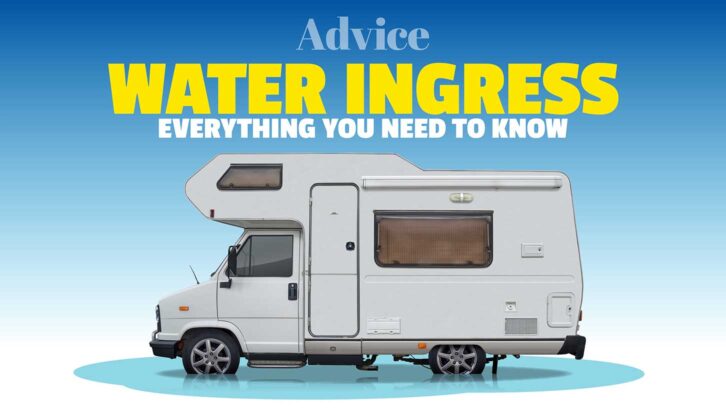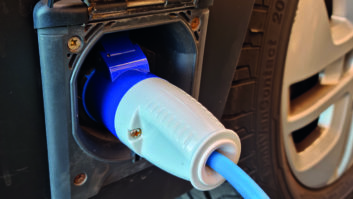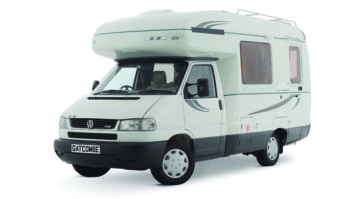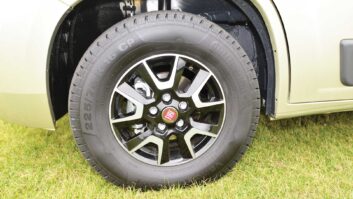Water ingress is something all ’van owners fear. Aesthetically sound leisure vehicles can be consumed by damp and mould without anyone knowing. But there’s no need to despair, for salvation is at hand!
Of course, 100% body integrity is the Holy Grail for coachbuilt motorhome makers, but despite their best endeavours over decades of building leisure vehicles, the problem hasn’t been eradicated.
These days, the evolution of some impressive new materials and clever construction methods has helped to improve things quite dramatically, although driving a big box along our pothole-riddled roads when on our way to one of the best motorhome sites can still reveal nasty flaws in a ‘van’s build, even in this age of aviation-quality adhesives and sealants.
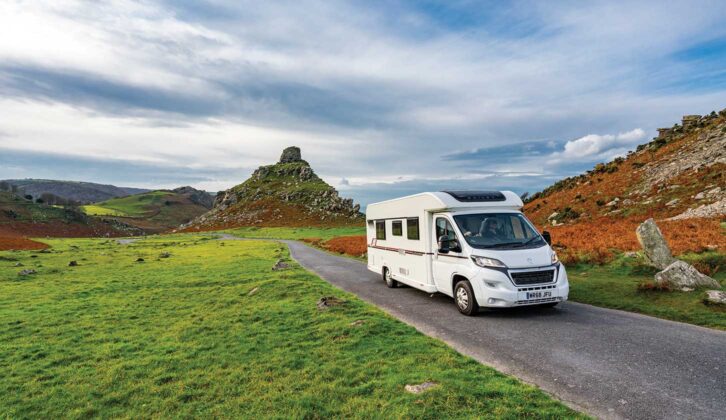
What’s the cause?
There are many ways water can find its way through the panels of a coachbuilt and into its internal structure.
In fact, any screw-hole, panel joint seal, window aperture or other type of addition to the vehicle’s walls has the potential to let water through.
Until about a decade ago, traditional methods of construction meant that many motorhomes were fixed together with hundreds of steel screws along the length of each panel join.
Of course, every one of those holes had the potential to let in moisture, creating corrosion and mould.
Likewise, the joins where wall panels met, or any appendage that penetrated the exterior wall (external sockets and lockers, or cable entry points, for example) were potential weak spots.
Often unseen, damp can work its way through any tiny gaps, past the ‘van’s first line of defence, undermining your efforts to prolong the life of your motorhome.
Heavy rainfall will make it worse, and the jet-wash effect of driving at 50mph or more in a rainstorm means that water can be forced in through even the smallest gaps.
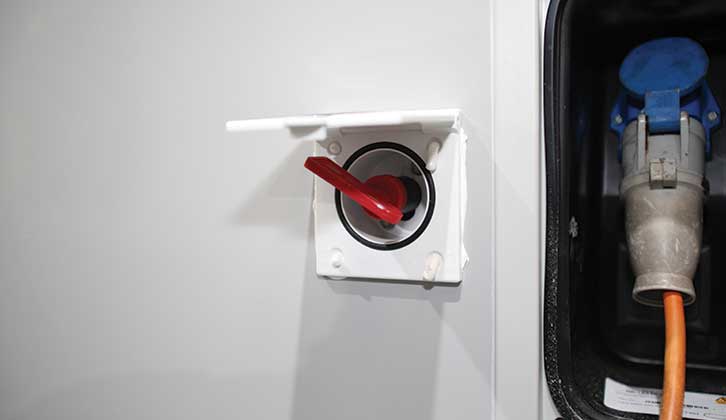
Once inside, the water can run down and spread out, being soaked up by the wooden framework of the motorhome, and the absorbent wall panelling and floor. And there it will sit, the porous wood sucking it up, then staying damp long after the rain has stopped.
Within weeks, the wood will have become discoloured and the moisture might well be topped up in that time. In a few months, rot sets in.
Meanwhile, unwitting motorhome owners are still enjoying their tours, completely unaware that their beloved ’van is already being attacked by the dreaded moisture menace.
Some time later, the owner might step inside their motorhome to be met by a musty, mildewy smell; they might notice some staining on an interior wall panel, or their annual service will highlight the fact that water has penetrated the vehicle.
And that’s where all too easily, things can start to get very expensive.
However, there is at least some good news. If you catch water ingress early enough, it’s a fairly straightforward job to track down the leak, seal it and dry out the woodwork. Delays, though, can lead to entrenched and extensive rot, and then you’re facing a much bigger challenge.
Motorhome construction
For decades, motorhomes were made in pretty much the same way, with internal panelling and external walls fixed to a framework of wood.
This was attached onto and around the metal chassis of the base vehicle.
In the earlier days, this worked well, because the motorhomes had excellent airflow, so condensation wasn’t such a big issue. Dampness dried out quickly, and perhaps people weren’t as fussy!
However, as vehicle design grew more sophisticated, they became sealed boxes, minimising the airflow and enabling moisture to be trapped inside indefinitely.
Sealants have always been used to fill panel gaps and wall joints. Until quite recently, these were prone to drying out and cracking, although these days, high-quality silicone sealants, which remain flexible for years, are used.
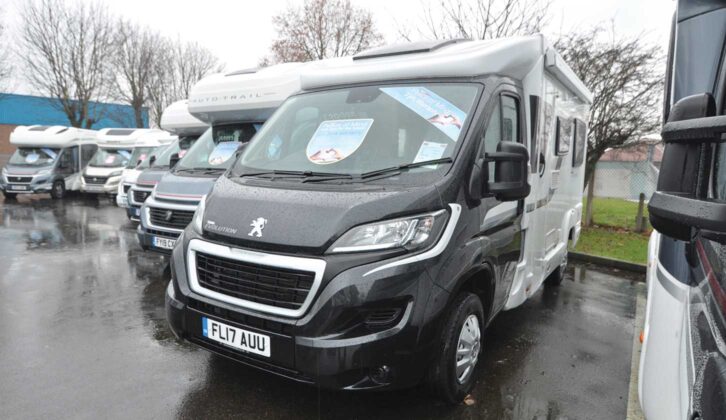
motorhome
Eventually, the major leisure vehicle manufacturers began to embrace more innovative construction methods, to make both their motorhomes and their caravans more waterproof and less susceptible to damp if it were to manage to find its way in.
Bailey was an early innovator in the field, with its launch of Alu-Tech in 2009. This features a rigid aluminium structure, instead of wood, creating an extremely strong shell that is impervious to moisture.
Shortly after that, Elddis introduced its SoLiD construction method. This replaced those hundreds of potentially leaky screw-holes in the panels with state-of-the-art panel bonding, using aircraft-grade adhesives.
Yours truly underwent SoLiD training and I have to say it was pretty impressive, sealing and fixing in one. Just never use the word ‘glue’ around an Elddis technician!
Swift also modernised, introducing composite materials instead of wood into its leisure vehicle walls and floor. In this way, even if any water does creep in, it won’t be soaked up and begin to cause rot.
How can I detect it?
There are three main ways that you’ll discover water ingress: you might spot dampness and discoloration in the motorhome’s interior walls, or perhaps notice a musty, mildewy odour. A service technician may also note its presence, using an electronic damp meter.
If there’s significant damp in your motorhome, you’ll smell it when you return to your vehicle after it has spent the winter months in storage.
Of course, if you can smell it, the rot has already set in; likewise if you spot stained panels. Far better, then, to have an expert technician test for damp at each annual service – and
any time you suspect a leak.
Damp tests should be a standard part of any motorhome service, and are essential in services carried out by AWS-registered technicians.
To perform a damp test, technicians use a small device with two metal prongs. These are gently pressed against the wall panels (they don’t leave a visible mark) and the current between the two indicates if there is excessive moisture in the panel.
The readout gives you a moisture percentage, with any reading around 15-20% being fine, but alarm bells might ring, especially if the reading is particularly high.
The key places to test are around the overcab area, window seals and wheel arches, and on inside wall panels where they align with external joints, especially lower down behind the sofas, furniture and radiators, and in overhead lockers and cupboards. Check around the skylights and the roof vents, too.
If you do detect any signs of damp, or you get a high damp meter reading, it’s time to contact your motorhome dealer or a service technician for further investigation of the problem.
Preventing water ingress
There are several ways that you can minimise the chances of water leaking into your motorhome. The most important is regular servicing, which should be carried out annually to maintain any warranties.
Warranties covering water ingress tend to be for extended periods, but are contingent on regular servicing, often within tight timescales. With new and warrantied ’vans, it makes sense to book your next year’s service when paying for the current one.
The condition of the sealant should be carefully checked, especially on older motorhomes.
Fitting one of the best motorhome covers can help to protect your ‘van in bad weather, and will protect sealants against UV degradation.
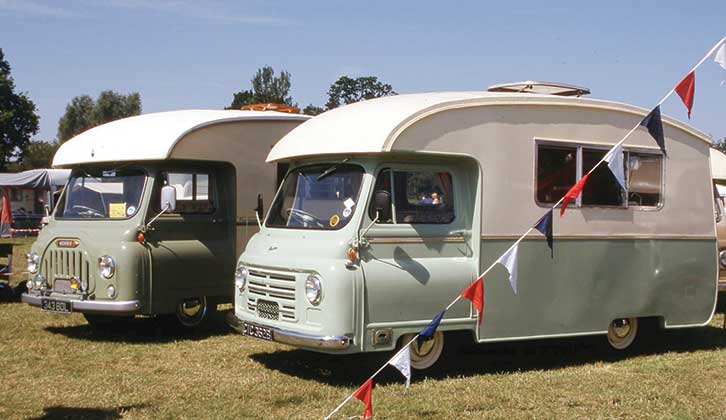
Covers made with breathable fabrics minimise any condensation build-up between the cover and the motorhome itself, just one of the reasons you should be considering a motorhome cover. Sitting water on the ’van’s roof makes water ingress and panel damage more likely.
Airflow around your motorhome is important, so an ideal scenario would be to store your vehicle underneath a carport-style structure, which protects it from the worst of the weather, but also provides good ventilation.
Indoor storage is an excellent choice, although it is always important for the ’van to be put away dry.
It also makes sense to air your ’van’s interior as often as possible. Efficient ventilation is a benefit, whatever the age of the motorhome.
Check your window and door seals regularly and keep them supple by using a silicone spray. If you don’t have any of that product to hand, many seasoned motorhome owners swear by olive oil as a lubricant.
Cracked and crazed rubber seals can easily let in moisture, so it’s really important to keep an eye on these and inspect them on a regular basis, to save on costly repairs.
Water ingress essentials
The causes
- Seal degradation: Over time, seals around windows, overcabs, doors and vents can deteriorate.
- Breakdown of sealants: Joints sealed with silicone are prone to leaking, because sealants can perish owing to age, weather and UV light.
- Cracks or damage: External damage, cracking or holes can create entry points for water.
- Poor maintenance: Neglecting regular motorhome maintenance, such as resealing seams and inspecting vulnerable areas, can lead to water ingress.
The effects
- Structural damage: Water ingress can compromise the ’van’s wooden framework, causing rot.
- Mould and mildew: Damp creates an ideal environment for mould and mildew, posing health risks and resulting in unpleasant odours.
- Aesthetic damage: Stains, bubbling wallpaper or peeling paint affect the ’van’s appearance and value.
- Electrical issues: Water can damage electrical systems.
Prevention and Remedies
- Regular inspection: Routinely inspect exterior, seals and seams for signs of wear or damage.
- Sealing maintenance: Reseal seams, joints and openings with a quality sealant, such as CT1 or Sikaflex.
- Proper storage: Store your ’van in a dry, covered area, or buy a good-quality breathable cover.
- Rapid repairs: Address water ingress issues promptly.
- Dehumidification: Consider a dehumidifier and ensure good ventilation in the vehicle – see our best motorhome dehumidifier guide if you’re after one.
- Professional help: If severe ingress is suspected, consult the experts for a Damp Report and repairs.
Dealing with water ingress
We visited Downtide Caravans & Leisure, in Norfolk, to watch their expert technicians repairing damage caused by water ingress. It’s a painstaking (and therefore costly) task
1. Wheel arches are a common source of damp, and even a small gap can allow in water. Working externally, the leaky area is fixed and sealed.
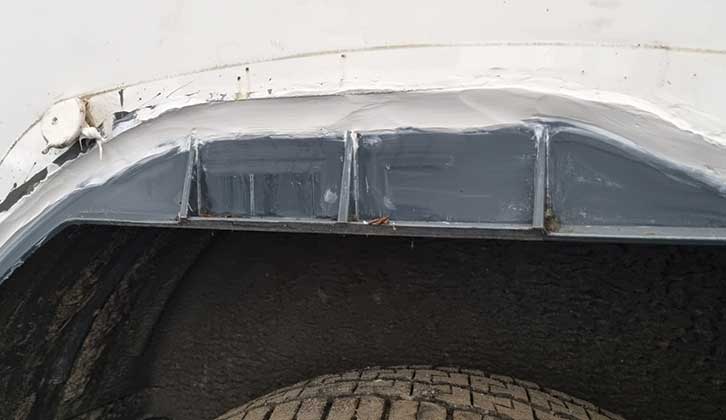
2. Inside, the area of dampness is quickly identified.
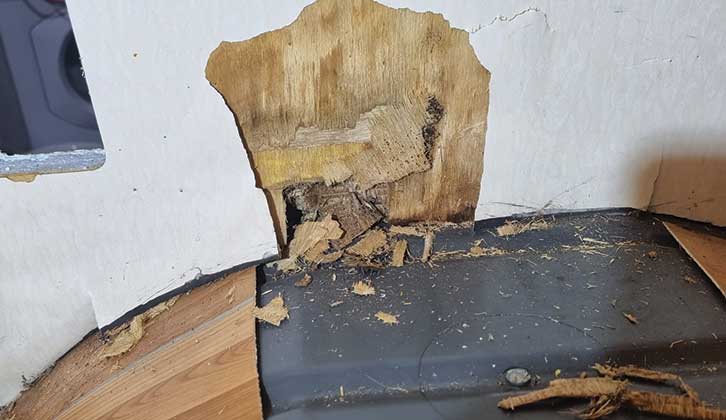
3. The rotten timber has to be removed. Often, this means having to replace an entire panel.
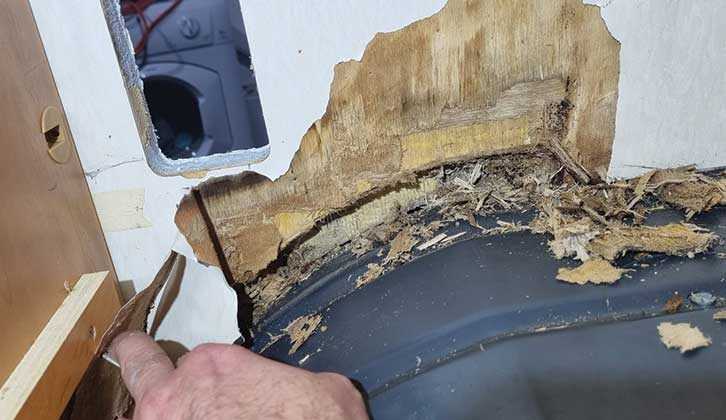
4. The rotten wood panelling is cut out.
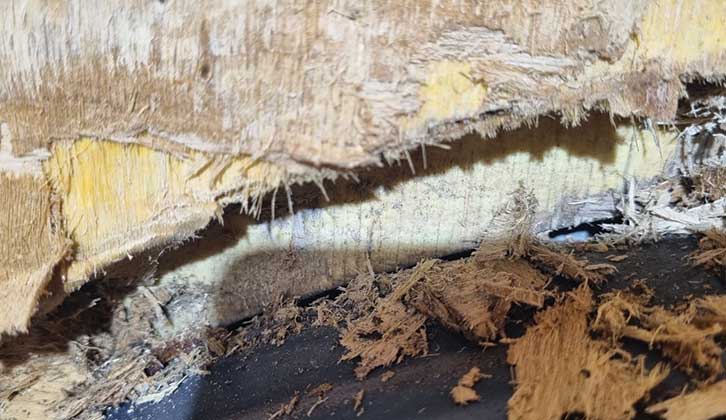
5. Finally, the framework can be replaced.
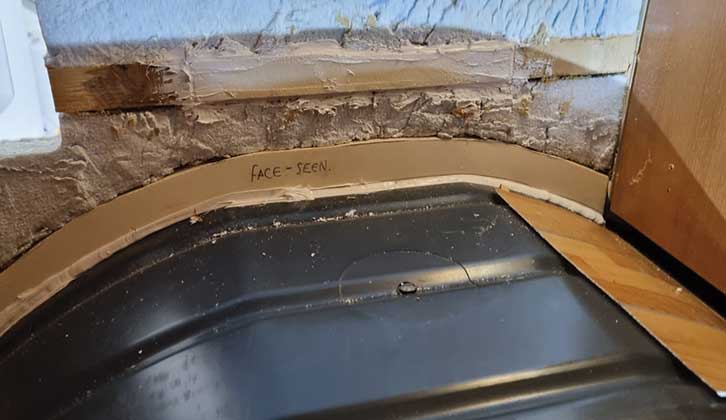
6. Interior panelling is stripped away to access the leak and rotten woodwork.
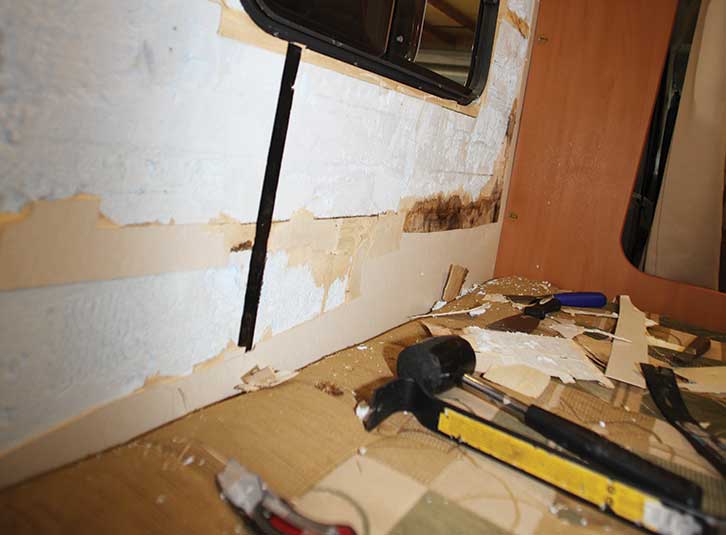
7. With the panel stripped off, the extent of the mould can be seen.
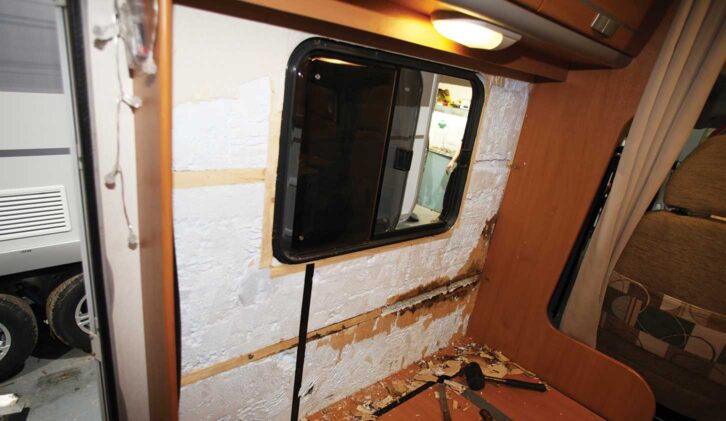
8. Rotten framework is stripped out.
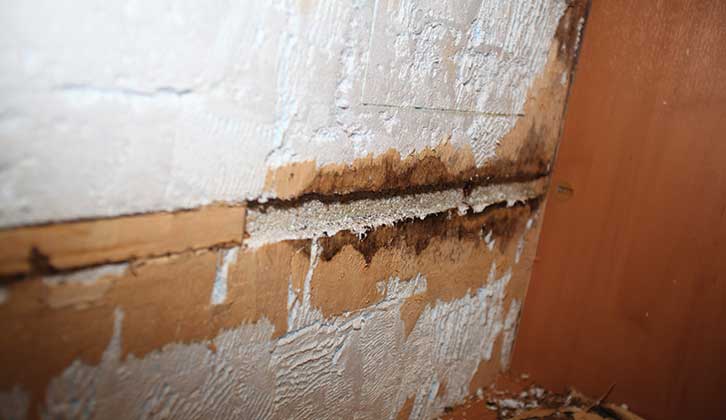
9. Matching wood panelling is cut to size and shape.
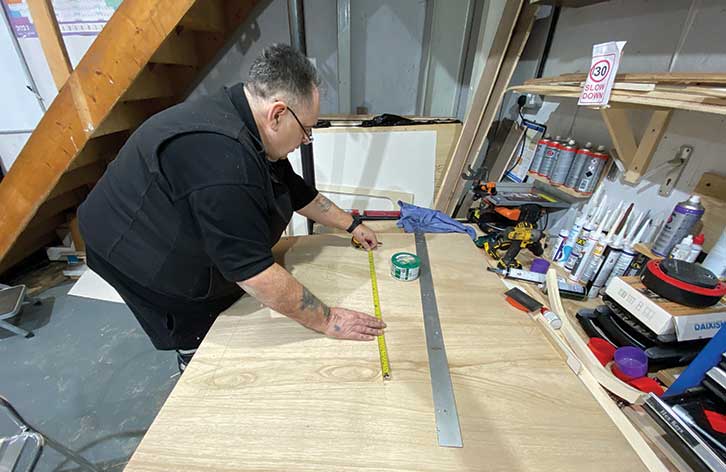
10. The wall panel is carefully copied to match the exact shape of the damaged one.
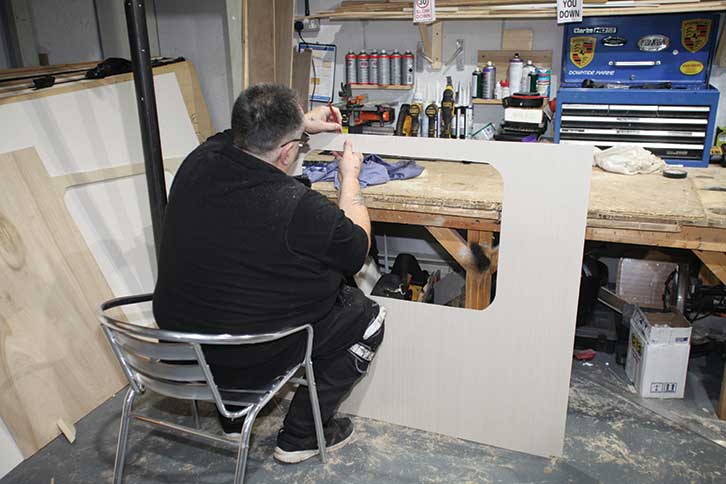
11. The replacement panel is offered up to the interior wall.
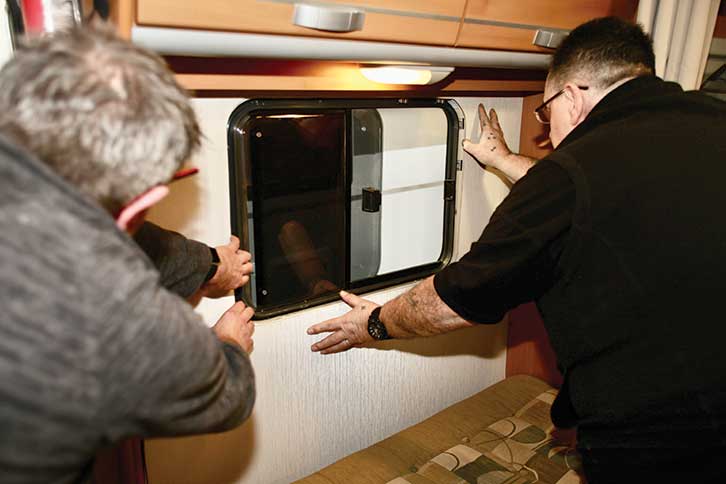
Future Publishing Limited, the publisher of Practical Motorhome, provides the information in this article in good faith and makes no representation as to its completeness or accuracy. Individuals carrying out the instructions do so at their own risk and must exercise their independent judgement in determining the appropriateness of the advice to their circumstances. Individuals should take appropriate safety precautions and be aware of the risk of electrocution when dealing with electrical products. To the fullest extent permitted by law, neither Future nor its employees or agents shall have any liability in connection with the use of this information. Double check any warranty is not affected before proceeding.
If you’ve enjoyed reading this article, why not get the latest news, reviews and features delivered direct to your door or inbox every month. Take advantage of our brilliant Practical Motorhome magazine SUBSCRIBERS’ OFFER and SIGN UP TO OUR NEWSLETTER for regular weekly updates on all things motorhome related.
